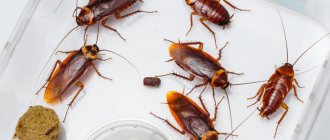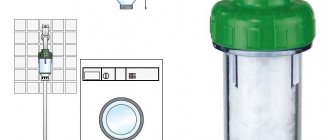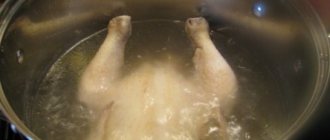Cockroaches have a reputation as tenacious and hardy household pests. It is known that these creatures are resistant to radiation and are also able to adapt to the effects of pesticides, which creates difficulties in the fight against cockroaches in apartments. In this regard, it is interesting how other factors influence how long domestic cockroaches live in residential areas. For example, how long does a cockroach live without water and food, can cockroaches live without air, and how the temperature of the environment affects the development of a cockroach.
How many years do cockroaches live?
If we turn to paleontological evidence, it is revealed that the history of cockroaches as an order of the insect class goes back hundreds of millions of years, going back to the Carboniferous period of the Paleozoic era. Let us note here the remarkable fact that the existence of humanity is negligibly short in comparison with how long cockroaches live. But these are ancient matters, and we are more interested in modern cockroaches living in apartments, or more precisely, how long a cockroach lives at home.
Description of the insect
It is perhaps difficult to find a person who does not know what an ordinary domestic cockroach looks like. Even if fate saved someone from personal acquaintance with these insects, then, probably, everyone in childhood read the fairy tale “The Cockroach” or watched a cartoon based on it.
So, what does an ordinary domestic cockroach look like and what is it like? First of all, a cockroach is an insect belonging to the order Cockroach. In addition to it, termites also belong to the same order, and in total there are more than 7570 species. Moreover, there are more than 4,640 species of real cockroaches alone.
The world's largest cockroaches live in Colombia and reach a length of 97 mm and a width of 45 mm. These giants crawl faster than all insects - at a speed of over 4 km/h.
Three hundred million years ago, cockroaches already lived on our planet. They crawled among the giant horsetails and mosses of the Carboniferous period, and now some of these unimaginably ancient creatures live alongside people.
During the day they hide in cracks, and at night they crawl out for food - bread crumbs, kitchen waste, not necessarily fresh. For lack of anything better, they can chew a dry rag, shoe polish, or drink ink. Their intestines, like those of their termite relatives, contain protozoa that help them digest this non-nutritive food.
Types of cockroaches
The most common “tenants” in human housing are the red cockroach (Prusak) and the black cockroach, the population of which had greatly thinned out by the beginning of the 21st century.
Red cockroach
Also known as Prusak. This insect received its second name because in Russia it was considered to come from Prussia, which is not at all true. In fact, the homeland of red cockroaches is not Germany or even Europe, but... southern Asia. It was from there that this insect came to European countries in the 18th century and, having chosen human dwellings as its habitat, began to actively reproduce, so much so that it soon supplanted its main “competitor” - the black cockroach.
The body length of an adult is from 1 to 1.6 cm. Both males and females of this species have very well developed wings, thanks to which cockroaches can glide, although they cannot truly fly.
The body of males is narrower than that of females, and the wings of males do not cover the last segments of the abdomen. The color of the red cockroach, strictly speaking, is not entirely red, but rather brownish in a variety of shades, sometimes they can even be almost black.
Prussians are omnivores: in addition to the “traditional” cockroach food - the remains of human food, they can eat paper, leather, textiles, wood glue, and will not even refuse ordinary soap if they do not come across any other food. But their most favorite delicacies are bread, pastries, as well as sugar and various sweets. The cockroach does not disdain meat or porridge, but he does not like fruit too much, although he eats them if there is nothing else available, and the freshness and quality of the fruit does not bother him too much.
Black beetle
Nowadays it is not such a frequent visitor to our homes, but in the past it was very common. Noticeably larger than the red cockroach: the length of an adult insect can be from 2 to 8 cm. The color is either black-brown or tar-brown with a pronounced metallic sheen. The males of this species have longer wings than the females, but black cockroaches cannot fly or even glide. But they run very fast. So quickly that before you have time to look back, there is no trace of him.
THIS IS INTERESTING! In Germany and the Czech Republic, black cockroaches are called “Swabians”, since they believe that these insects were brought from Swabia, an area in southern Germany.
How long does a domestic cockroach live?
The life cycle and how quickly cockroaches grow after hatching depends, firstly, on the species of cockroaches, and secondly, on the external conditions where they live. The life of all cockroaches begins with the laying of eggs hidden in a capsule called an ooteca, then cockroaches pass through a series of larval stages and eventually develop into adult insects. Of the more than 4,000 species of cockroaches found in homes, the majority are red, black, and American.
How long does the Prusak cockroach live?
The female red cockroach sheds a capsule, or ootheca, containing 30-40 eggs 1-2 days before the newborn nymphs emerge. Depending on environmental conditions, the period of development from egg to adult in red cockroaches varies between 50-200 days, the average period is 100 days. The lifespan of adult Prussians is 100-200 days.
How long does a black cockroach live?
Male black cockroaches live on average 110-160 days, while females have a life expectancy of up to 180 days. During this time, they manage to lay 8-12 oothecae, 15-16 eggs in each. The period of development from egg to adult in black cockroaches includes 7-10 intermediate larval stages and depends on the ambient temperature.
When eggs appear in the summer months in warm climate zones, the development time takes up to 200 days, but in conditions of prolonged cold weather they can reach 800 days. The average development period is 500-600 days, so the total lifespan of black cockroaches is about two years.
How long does an American cockroach live?
The American cockroach is the largest (up to 50 mm in length) and long-lived representative of synanthropic cockroaches. The incubation period of eggs lasts 40-45 days, and the complete period of development to adulthood, which includes 10-13 larval stages, is 600 days. Adult males live up to 360 days, and females up to 700 days, so long-lived American cockroaches can live more than three years.
Habitats and habits
This question is of interest to many. The owners of the apartments and houses in which these guests live are especially interested in him. These insects are unusually tenacious creatures. They survive without food for 40 days. And absolutely everything serves as food for them, even concrete and brick. The main condition for their life is the presence of water. That's why they settle closer to its sources.
In an apartment, such places are the bathroom and kitchen. When water is found, insects begin to look for food. Their digestive system is designed in such a way that it digests a wide variety of organic products.
After about 2-4 weeks, females shed their offspring, hiding them in an inaccessible place
A common property of representatives of this family is the incomplete cycle of their biological development. They do not have the stage of transformation of larvae into pupae. Females carry fertilized eggs on their stomachs in a special container called an ootheca. The eggs grow over time, and the ootheca also swells and becomes heavier.
After 2, maximum 4, weeks, the offspring are shed in a warm place with sufficient humidity. Nymphs hatch from the ootheca. These are small (up to 2-3 mm) white cockroaches. The nymphs gradually turn black and their shell hardens. Several moults pass before the nymph turns into an adult cockroach.
The lifespan of an adult is 20-30 weeks.
For their habitat, insects usually prefer secluded corners in hard-to-reach places. They can be found behind or under the refrigerator, under the sink, baseboard, and in various crevices. In their corners they live in fairly large groups. During the day, they try not to crawl out of their burrows, since their mode of life is nocturnal. At night and early in the morning, when everyone in the house is asleep, they manage to eat crumbs and small pieces of food that they find on the floor or on the kitchen table. In daylight, they appear only in cases where their burrows do not contain all the individuals. Their appearance during the day is a signal to take measures to destroy insects.
To more effectively fight cockroaches, you need to know where they live. Insects to look for:
- Under the refrigerator
- Behind the refrigerator
- Under the sink
- Under the bath
- Behind heating appliances and pipes
- Under the baseboards
- Behind kitchen cabinets
- In cabinet door hanging mechanisms
- In trash cans.
These are their most favorite places of settlement.
Whether a cockroach lives in a particular place can be easily determined by the smell and by the black spots of feces remaining in places where insects actively live.
They live without food for several weeks, without water for no more than a week.
They feed mainly on foods high in organic matter:
- Sweets and sugar
- Beer
- xBread crumbs and flour products
- toilet paper and napkins
- Meat
- Wallpaper and glue
- Spoiled and rotting products
- Stockings, socks and underwear
- Books, magazines, newspapers
At what temperature do cockroaches live?
Cockroaches are heat-loving creatures, and for this reason they love living in people's homes. Temperatures between 20-30 degrees Celsius are optimal for the reproduction and development of the cockroach population. As the temperature drops, the biological processes in the body of these insects gradually slow down. When the thermometer drops below zero, cockroaches die within 4-8 hours. An increase in temperature to +50 degrees and above leads to dehydration of cockroaches, as a result of which they also die.
Black cockroaches are more adapted to low temperatures than red ones, and therefore in warm latitudes they live not only indoors, but also outdoors. However, if the air temperature drops below +15 degrees, black cockroaches stop reproducing.
For what reasons do they appear in a particular residential area?
There are several reasons:
- unsanitary conditions. Always dirty floors, unwashed dishes, cluttered corners, food residues lying around in different places (this could be spilled sugar or flour);
- things from trips. An insect can come to your home in a travel bag, having entered it from a hotel or train carriage;
- dysfunctional neighbors. It doesn’t matter which side the sluts are next to you (above, below, through the wall). Cockroaches will definitely get into your apartment from the ventilation hole or cracks in the walls and floor;
- faulty water and sewer pipes. Small damp places under the drop and warmth - this is a real cockroach paradise. As long as there is moisture nearby and the temperature in the apartment does not drop below 10 degrees, the Prussians will be ready to live with you forever.
We suggest you read: How to remove fleas from a cat at home
How long do cockroaches live without food, water and air?
Cockroaches are cold-blooded organisms; they do not waste energy to maintain the required body temperature, which allows them to endure hunger for a relatively long time. Depending on the species, cockroaches can survive without food from seven days to one month.
But without water, these insects will last no more than a week, so cockroaches prefer those rooms in the apartment where water sources are available. And if you make sure that in the kitchen and bathroom there are no drops of water left in sinks, under the refrigerator, in the shower stall, on pipes, faucets and other places, this will help reduce the cockroach population.
Scientific research confirms that cockroaches are able to hold their breath and, if necessary, go without air for up to 30-40 minutes, for example, when under water. Scientists are studying whether cockroaches use this ability to prevent moisture loss in the body. The fact is that the tubes called spiracles, which are used when cockroaches breathe, are also used to transport water. If these channels are closed, cockroaches retain moisture inside their bodies.
What about the brain?
The digestive system still plays an important role, since the cockroach still absorbs food through the mouth. But even without a head, he can live for ten days if he has had a hearty lunch beforehand. It is much more likely to be killed by mold or other insects than by starvation.
Many may ask: “What about the brain?”, and they will still be mistaken. A cockroach has more than one brain in the usual sense. In every part of his body there are nerve nodes that are responsible for body movements and other sensations. The loss of a head is simply the loss of one of the departments, nothing more. But, despite such skills, the head is still not as durable as the body. Therefore, she will “live” much less.
As you can see, most of the legends were still confirmed, therefore, in order to prevent the appearance of these parasites in your home, you need to carefully monitor the water in the house first of all. Cockroaches will live quite a long time without food and a head, but they cannot survive without water, so they are attracted to damp places.
Can a cockroach live without a head?
This sounds like science fiction, but it is a true fact, confirmed experimentally. The body of the cockroach actually continues to live after decapitation, and even the head, separate from the body, moves its antennae for several hours.
Scientific American provided a detailed explanation of this phenomenon by biochemist Joseph Kunkel of the University of Massachusetts, who studies the development of cockroaches. The scientist explained the differences in the structure of the respiratory, circulatory and nervous systems of insects from vertebrates.
It turns out that cockroaches don't use their heads to breathe; they breathe through spiracles, or tiny holes located on each body segment. In this case, oxygen enters the tissues directly through the trachea, and not through the blood, and even the brain does not participate in this process. The circulatory system of cockroaches is not closed, and cutting off the head does not lead to a critical drop in blood pressure and uncontrolled bleeding.
Within each segment of the insect body, clusters of ganglion-nervous tissue agglomerations are evenly distributed, which perform the nervous functions responsible for reflexes. Therefore, in the absence of a brain, the body continues to function at the level of elementary reactions - it can stand, respond to touch and move. Experimental research on this topic was conducted by entomologist Christopher Tipping at Delaware Valley College in Doylestown, Pennsylvania.
In laboratory conditions, in which the researchers sealed the wound with dental wax to protect the body from dehydration and infection, the cockroaches survived headless for several weeks. In real conditions, of course, the survival time is much shorter. Some sources claim that a cockroach lives without a head for 9 days, others give longer or shorter periods. One way or another, the insect eventually dies from bacterial infections or from dehydration, since cockroaches without a head cannot drink.
Reproduction
It is important and interesting that it is enough for female representatives to mate with a male once in their life. Subsequently, the eggs are fertilized by seed material stored in a special section of her body. After some time, the female cockroach lays eggs in a dense bag of foamed protein substance formed for this purpose (the protein hardens, turning into reliable protection for future babies: such a capsule does not allow water and toxic substances to pass through, and is difficult to crush). For some time - a day or several weeks (depending on the type of individual) - the female carries this capsule within herself, dragging behind her the part that protrudes beyond the edges of the abdomen. This happens while the masonry is increasing. Then she dumps the container in a secluded place where there is enough moisture and warmth.
The development of larvae takes a short period - only a few weeks. As a result of this process, absolutely healthy individuals are born, adapted to life in the surrounding world. The insects are very prolific - one clutch can contain up to fifty larvae. Small insects, whitish in color and about 3 mm long, quickly scatter in search of food and to grow (a growing organism requires strength and energy). After some time, their skin hardens, turning into chitin. Before they fully mature, several molts will pass, and the cockroaches will acquire the color characteristic of their species.
The development process is directly related to environmental temperature. If it fluctuates within 30°C, then all molting takes place in 2 months, and if it is around 20°C, in six months.
Cockroaches are not viviparous insects, although this may be the impression of some of them. They don't have to give birth. There are species in which the eggs develop inside the female's body. An example of this is the Madagascar cockroach. The capsule with eggs remains inside the insect throughout its development, and only a few times a day a pregnant cockroach puts them outside for ventilation. The larvae have to be born from the egg also inside the mother’s body and quickly leave the brood chamber. An outside observer gets the impression that the cockroach is giving birth. As a rule, the birth process of cockroaches lasts from several minutes to several hours.
Do cockroaches and bedbugs live together?
On the Internet, there are comments from users who say that bed bugs do not live with cockroaches under the same roof, and that they allegedly displace the other. But this statement is not confirmed in practice. Both bedbugs and cockroaches have natural insect enemies, such as flycatchers or predatory wasps, but these species do not pose a danger to each other.
Bedbugs and cockroaches live together without problems, since their food and territorial interests do not overlap. Even with high numbers of both populations, when these species coexist, for example, in the same dorm room, they do not conflict with each other.
Do they cause harm to humans?
IMPORTANT! Red cockroaches are dangerous to humans: constantly in contact with garbage, household waste, dirt, they are carriers of pathogenic bacteria, as well as worm eggs.
Intestinal disorders, tuberculosis, helminthiasis are just a few of the diseases that Prussians can bring on their paws.
Scientists knew of several cases when these pests ate away the keratinized parts of the dermis on the face and hands of people, but did not cause any tangible harm to them. So we can safely say that Prussians do not bite.
Do cockroaches live where ants live?
Ants are also synanthropic pests, and their paths in the apartment often intersect with the habitat of cockroaches. As for food, these insects have largely the same tastes, and both are equally dependent on water. At the same time, cockroaches and ants in some cases live in a private house or in an apartment - together, and do not fight with each other.
However, this neighborhood cannot be called cloudless and peaceful either. Although cockroaches, like ants, are polyvorous, they do not attack living insects but feed on organic waste, including carrion and feces. Ants, in turn, abhor carrion and sewage, but they hunt insects that get in their way, including cockroaches. So, at times, isolated cockroaches become victims of ants, but there is no talk of severe species competition among these domestic pests.
Dmitry Lipchiu
Please rate the material
comments powered by HyperComments
Proven remedies
Considering that the average lifespan of longhorned beetles is 6 months, their population in an apartment or country house is rapidly increasing. To prevent such an outcome, it is necessary to destroy arthropod pests.
Among the means used for the fight are:
- Insecticidal drugs. They are sold in agricultural and specialty stores. These drugs include aerosols, tablets, gels and powders. They differ in composition, properties and effectiveness.
- Boric acid. This component is used when preparing baits at home. Boric acid is mixed with egg yolk, boiled potatoes or sugar. Sometimes vegetable or baby oil is added to the mixture, which has an attractive aroma.
- Compositions that have a pungent odor. So, housewives use vinegar or essential oils. They are introduced into water, which is used to clean surfaces in the apartment.
The lifespan of cockroach-like insects depends on the conditions in the apartment and the availability of food and water. If you consider how long an insect lives without water or organic matter, it is easier to destroy it.
Stages of insect life in optimal conditions
How do these insects live? These are quite mobile creatures, they love warmth and moisture, and are nocturnal (they hide in a dark place during the day and crawl out at night in search of food). Winged birds can fly to the light at night. They feed on plant and animal remains. And, of course, they multiply quickly.
These are the hardiest insects: certain subspecies and individuals can go without food for a very long time! The body of the insect is oval and flat. The length of an adult cockroach ranges from 1.7-2 cm to 9.5 cm or more. The structure of the body allows it to hide in any crevice.
We suggest you read: How to clean a carpet from pet hair
Lifespan
How many years do these insects live? The lifespan of cockroaches depends on external conditions. If there is enough moisture, food and warmth, then an adult red locust can survive for 1 year. The lifespan of the black one is 2 years (the development of this species is slower), and the Madagascar one (in a terrarium) can live from 3 to 5 years, depending on care.
The life cycle of a cockroach can be divided into 3 stages of development: egg, larva, adult insect. The most important thing for this beetle is to be fruitful and multiply, giving life to new cockroaches. The female attracts the male with odorous substances secreted by special glands. Some individuals court females for a certain time, but the result is the same - fertilization.
Temperature influences the activity of barbels. Arthropod pests are attracted to warmth, which is why they move into apartments and country houses. Insects are active if the temperature varies between 2 and 28 degrees. It’s always warm in living quarters, which is why Prussians settle next to people.
To reduce the life expectancy of cockroaches, it is necessary to reduce the temperature in the apartment to -5 degrees. Within half an hour, the vital functions of the barbels slow down and stop completely. If the temperature drops to -10 - -15 degrees, then the death of the Prussians occurs much faster.
High temperature also has an impact on the life processes of arthropod pests. If you raise the temperature to 28–30 degrees, the barbel will begin to lose moisture, which is difficult for them to do without. Therefore, some housewives use boiling water to fight.
The red cockroach (Blattella germanica), or Russian cockroach, is an insect of a brownish-red color, with two dark stripes on the front of the back, about 10-13 mm long in adulthood.
The home locust belongs to the section of insects with incomplete transformation, i.e. to those in which development after hatching does not include a sedentary and non-feeding pupal stage.
Stages of development of red cockroaches:
- Eggs. The female cockroach lays eggs in an elongated and slightly compressed capsule from the sides - the ooteca. Eggs are placed in two rows across the longitudinal axis of the capsule, the number of which ranges from 15 to 40 pieces. Each female German can lay from 3 to 7 ootheca during her life. The duration of egg maturation is 14-35 days.
- Nymphs (larvae). From the eggs, larvae or nymphs are born, the bodies and limbs of which are almost the same as those of adults. However, unlike sexually mature insects, the larvae do not have wings, they are smaller in size and darker in color. As the nymphs grow, they molt 5 to 9 times and turn into full-fledged cockroaches, ready for further reproduction. This stage lasts about 2 months.
- Imago (adults). The adult life span of Prussians can range from 20 to 30 weeks.
Thus, the full life cycle of the red cockroach from the moment the larva emerges from the egg until death from natural aging of the body is approximately 170 days (about 6 months).
Black cockroaches (Blatta orientalis) are a large species of domestic pest, 15-32 mm long. They have a brown-black body with a glossy, “varnished” surface. Insects go through the same stages of development as red locusts, but much more slowly.
The duration of the development and life cycle of cockroaches is different for each species and varies greatly depending on the temperature conditions under which they live. Whiskered "house robbers" are heat-loving insects and prefer to live in warm and moist shelters. During daylight hours, they hide from human eyes, going out in search of food at night.
Lifespan of cockroaches (Prussians) depending on ambient temperature:
- at 22-24 degrees - 6-9 months;
- at 26-30 - 3-5 months;
- 5 degrees is a critical temperature for insect life;
- at 0-5 degrees - both larvae and adults die within 30 minutes;
- at temperatures below 0, cockroaches die within 1-2 minutes.
A decrease in ambient temperature significantly lengthens the developmental stage of nymphs, since the larvae are less vulnerable to cold weather. In the cold season, the development stage of Prussian nymphs can last for 4-5 months.
The lifespan of black cockroaches under unfavorable conditions is also reduced and is about 2 years. However, cold is more destructive for this species. The death of individuals can be observed already when the temperature drops to 7-10 degrees.
There are known cases when, with the onset of cold weather, all adult individuals and larvae of cockroaches died, and the eggs overwintered safely in the shed swellings.











